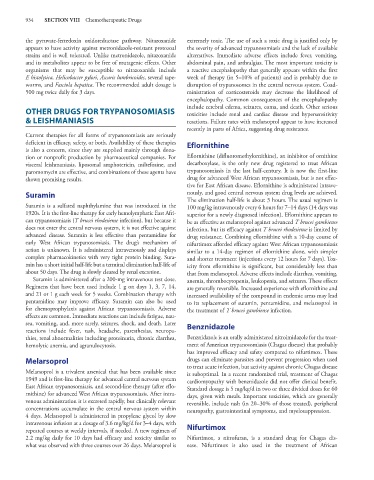Page 948 - Basic _ Clinical Pharmacology ( PDFDrive )
P. 948
934 SECTION VIII Chemotherapeutic Drugs
the pyruvate-ferredoxin oxidoreductase pathway. Nitazoxanide extremely toxic. The use of such a toxic drug is justified only by
appears to have activity against metronidazole-resistant protozoal the severity of advanced trypanosomiasis and the lack of available
strains and is well tolerated. Unlike metronidazole, nitazoxanide alternatives. Immediate adverse effects include fever, vomiting,
and its metabolites appear to be free of mutagenic effects. Other abdominal pain, and arthralgias. The most important toxicity is
organisms that may be susceptible to nitazoxanide include a reactive encephalopathy that generally appears within the first
E histolytica, Helicobacter pylori, Ascaris lumbricoides, several tape- week of therapy (in 5–10% of patients) and is probably due to
worms, and Fasciola hepatica. The recommended adult dosage is disruption of trypanosomes in the central nervous system. Coad-
500 mg twice daily for 3 days. ministration of corticosteroids may decrease the likelihood of
encephalopathy. Common consequences of the encephalopathy
include cerebral edema, seizures, coma, and death. Other serious
OTHER DRUGS FOR TRYPANOSOMIASIS toxicities include renal and cardiac disease and hypersensitivity
& LEISHMANIASIS reactions. Failure rates with melarsoprol appear to have increased
recently in parts of Africa, suggesting drug resistance.
Current therapies for all forms of trypanosomiasis are seriously
deficient in efficacy, safety, or both. Availability of these therapies Eflornithine
is also a concern, since they are supplied mainly through dona-
tion or nonprofit production by pharmaceutical companies. For Eflornithine (difluoromethylornithine), an inhibitor of ornithine
visceral leishmaniasis, liposomal amphotericin, miltefosine, and decarboxylase, is the only new drug registered to treat African
paromomycin are effective, and combinations of these agents have trypanosomiasis in the last half-century. It is now the first-line
shown promising results. drug for advanced West African trypanosomiasis, but is not effec-
tive for East African disease. Eflornithine is administered intrave-
Suramin nously, and good central nervous system drug levels are achieved.
The elimination half-life is about 3 hours. The usual regimen is
Suramin is a sulfated naphthylamine that was introduced in the 100 mg/kg intravenously every 6 hours for 7–14 days (14 days was
1920s. It is the first-line therapy for early hemolymphatic East Afri- superior for a newly diagnosed infection). Eflornithine appears to
can trypanosomiasis (T brucei rhodesiense infection), but because it be as effective as melarsoprol against advanced T brucei gambiense
does not enter the central nervous system, it is not effective against infection, but its efficacy against T brucei rhodesiense is limited by
advanced disease. Suramin is less effective than pentamidine for drug resistance. Combining eflornithine with a 10-day course of
early West African trypanosomiasis. The drug’s mechanism of nifurtimox afforded efficacy against West African trypanosomiasis
action is unknown. It is administered intravenously and displays similar to a 14-day regimen of eflornithine alone, with simpler
complex pharmacokinetics with very tight protein binding. Sura- and shorter treatment (injections every 12 hours for 7 days). Tox-
min has a short initial half-life but a terminal elimination half-life of icity from eflornithine is significant, but considerably less than
about 50 days. The drug is slowly cleared by renal excretion. that from melarsoprol. Adverse effects include diarrhea, vomiting,
Suramin is administered after a 200-mg intravenous test dose. anemia, thrombocytopenia, leukopenia, and seizures. These effects
Regimens that have been used include 1 g on days 1, 3, 7, 14, are generally reversible. Increased experience with eflornithine and
and 21 or 1 g each week for 5 weeks. Combination therapy with increased availability of the compound in endemic areas may lead
pentamidine may improve efficacy. Suramin can also be used to its replacement of suramin, pentamidine, and melarsoprol in
for chemoprophylaxis against African trypanosomiasis. Adverse the treatment of T brucei gambiense infection.
effects are common. Immediate reactions can include fatigue, nau-
sea, vomiting, and, more rarely, seizures, shock, and death. Later Benznidazole
reactions include fever, rash, headache, paresthesias, neuropa-
thies, renal abnormalities including proteinuria, chronic diarrhea, Benznidazole is an orally administered nitroimidazole for the treat-
hemolytic anemia, and agranulocytosis. ment of American trypanosomiasis (Chagas disease) that probably
has improved efficacy and safety compared to nifurtimox. These
Melarsoprol drugs can eliminate parasites and prevent progression when used
to treat acute infection, but activity against chronic Chagas disease
Melarsoprol is a trivalent arsenical that has been available since is suboptimal. In a recent randomized trial, treatment of Chagas
1949 and is first-line therapy for advanced central nervous system cardiomyopathy with benznidazole did not offer clinical benefit.
East African trypanosomiasis, and second-line therapy (after eflo- Standard dosage is 5 mg/kg/d in two or three divided doses for 60
rnithine) for advanced West African trypanosomiasis. After intra- days, given with meals. Important toxicities, which are generally
venous administration it is excreted rapidly, but clinically relevant reversible, include rash (in 20–30% of those treated), peripheral
concentrations accumulate in the central nervous system within neuropathy, gastrointestinal symptoms, and myelosuppression.
4 days. Melarsoprol is administered in propylene glycol by slow
intravenous infusion at a dosage of 3.6 mg/kg/d for 3–4 days, with Nifurtimox
repeated courses at weekly intervals, if needed. A new regimen of
2.2 mg/kg daily for 10 days had efficacy and toxicity similar to Nifurtimox, a nitrofuran, is a standard drug for Chagas dis-
what was observed with three courses over 26 days. Melarsoprol is ease. Nifurtimox is also used in the treatment of African

